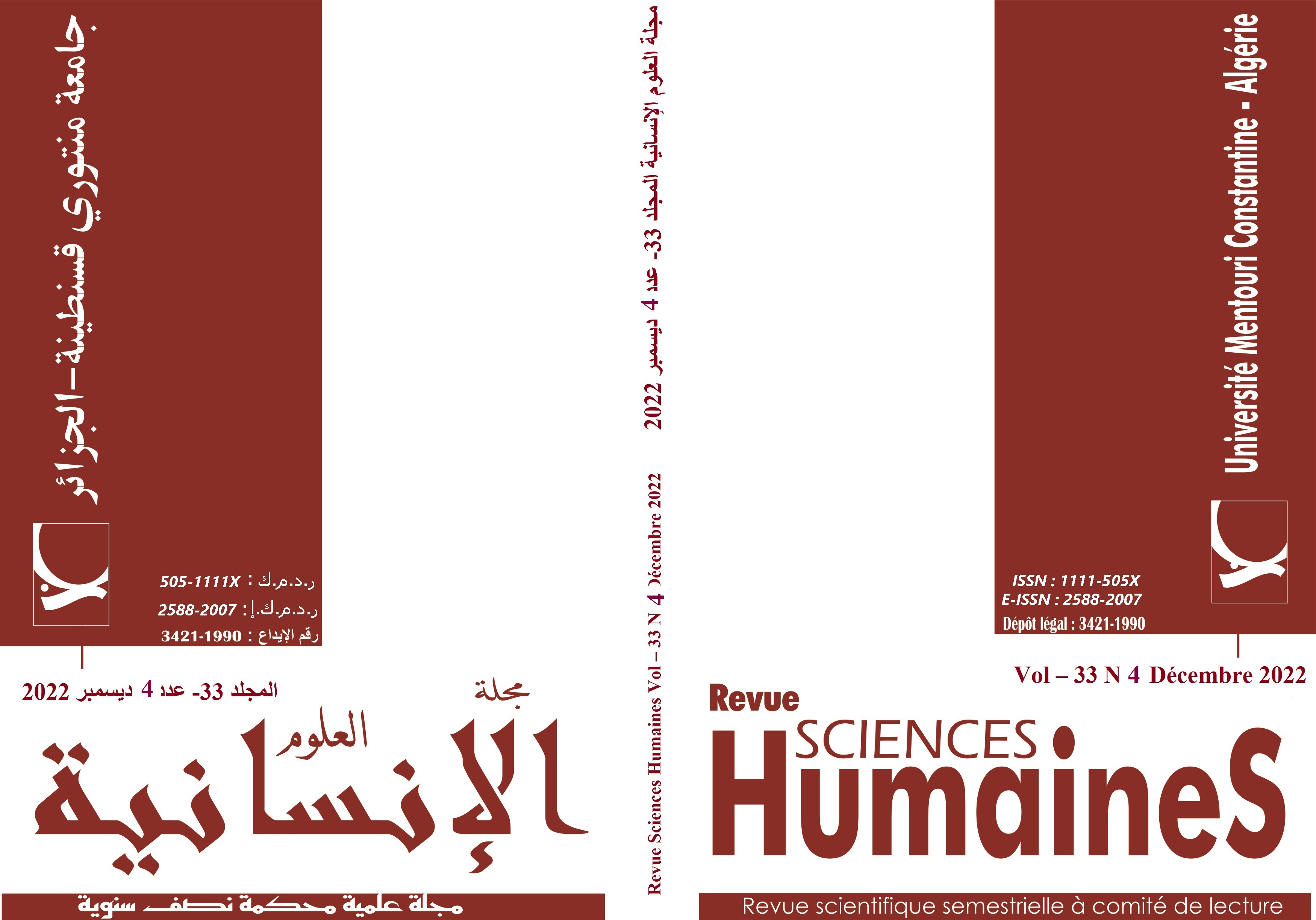Integrated-Skills and Segregated-skills approaches in the teaching of Speaking for EFL Learners
Mots-clés :
Approche des compétences intégrées, Approche des compétences séparées, Compétence orale, Macro et micro compétences, Expression OraleRésumé
La présente étude vise à explorer laquelle des deux approches les enseignants suivent pour enseigner la compétence orale dans le module d'Expression Orale : l'approche des compétences intégrées ou l'approche des compétences séparées. Il tente en outre d'examiner le processus d'apprentissage/enseignement de la compétence orale et son intégration avec les autres macro et micro compétences. L'étude prend le cas d'étudiants de première année, au Département de Lettres et Langue Anglaise, Université Frères Mentouri Constantine 1. Pour atteindre cet objectif, deux questionnaires sont adoptés. Le premier est attribué à 120 étudiants de première année et un second à 21 professeurs d'Expression Orale. Les résultats obtenus ont confirmé que les macro et micro compétences étaient combinées, mais elles étaient arbitrairement intégrées ; c'est pourquoi l'approche intégrée n'a pas été correctement appliquée.
Téléchargements
Références
. Aneela, A. & Ameela, A. (2010). Integration of language learning skills in second language acquisition. International Journal of Arts and Sciences, 3(14), 231-240.
. Aydoğan, H. & Akbarov, A. (2014). The four basic language skills, whole language and integrated skill approach in Mainstream University Classrooms in Turkey. Mediterranean Journal of Social Sciences, 5(9), 672-680.
. Beatris, M.N (2014). Integrated approach in teaching English language: The Practice in Kenya. International Journal of Education and Research, 2(4), 253-264.
. Brooks-Harper, G. and Shelton, P. W. (2003). Revisiting whole language development: A Transactional Approach to learning. Research for Educational Reform, 81, 35-42.
. Brown, H.D. (2000). Principles of language learning and teaching (4th Ed.). Englewood Cliffs NJ: Prentice-Hall.
. Goodman, K. (1986). What’s whole in whole language. Portsmouth, NH: Heinemann.
. Edelsky, C., Altwerger, B., and Flores, B. (1991). What’s whole language: What’s the difference. Portsmouth, NH: Heinemann.
. Finocchiaro, M. & Bonomo, M. (1973). The foreign language learner. New York: Regents Publishing Comp Inc.
. Harste, J., Woodward, V. and Burke, C. (1984). Language stories and literacy lessons. Portmouth, NH: Heinemann
. Hymes, D. (1972). On communicative competence. In J. Pride & J. Holmes (Eds.), Sociolinguistics (pp. 269–93). Harmondsworth, England: Penguin Books.
. Larsen-Freeman, D. (2000) Techniques and principles in language teaching. 2nd ed. Oxford: Oxford University.
. Moghadam, J. N. and Reza Adel, S. M. (2011). The importance of whole language approach in teaching English to intermediate Iranian EFL learners. Theory and Practice in Language Studies, 1(11), 1643-1654.
. Mohan, B. (1986). Language and content. Reading, MA: Addison-Wesley.
. Oxford, R., Lavine, R., crookall, D. (1989). Language learning strategies, the Communicative Approach, and their class implications, Foreign Language Annals, 22 (1) pp. 29-39
. Oxford, R., L. (1990). Language Learning Strategies: What Every Teacher Should Know. Bastion: Heinle & Heinle.
. Oxford, R.L. (2001). Integrated skills in the ESL/EFL classroom. ESL Magazine, 16(1), 111-136.
. Peregoy, S. F. (1983). Communicative competence: theory and classroom practice. Massachussetts: Addision Wesley Langman.
. Peregoy, S. F. & Boyle, O.F. (2001). Reading, writing, and learning in ESL. New York: Addision Wesley Langman.
. Richards, J. C. (2003). Current trends in teaching listening and speaking. The Language Teacher, 27(7), 3-6
. Savignon (1991). Communicative learning teaching: state of the art. TESOL Quarterly, 25, 261-277.
. Weaver, C. (1990). Understanding whole language: from principles to practice. Portsmouth, NH: Heinmann.
.Schwarzer, D. (2001). Whole language in a foreign language class: From theory to practice. Foreign Language Annals, 34, 52-59.
.Widiati, U., & Cahyono, B. Y. (2006). The teaching of EFL speaking in the Indonesian context: the state of the art. Bahasa dan seni, 34(2), 269-292.
.Yang,Y.I.J (2014). Is speaking fluency strand necessary for the college students to develop in the EFL class? Theory and Practice in Language Studies, 4, (2), 225-231
. Zhang, Y. (2009). Reading to speak: integrating oral communication skills. English Teaching Forum, 47, 32-34.
Téléchargements
Publié-e
Comment citer
Numéro
Rubrique
Licence
© Revue des Sciences Humaines 2023

Cette œuvre est sous licence Creative Commons Attribution - Pas d'Utilisation Commerciale - Pas de Modification 4.0 International.
















